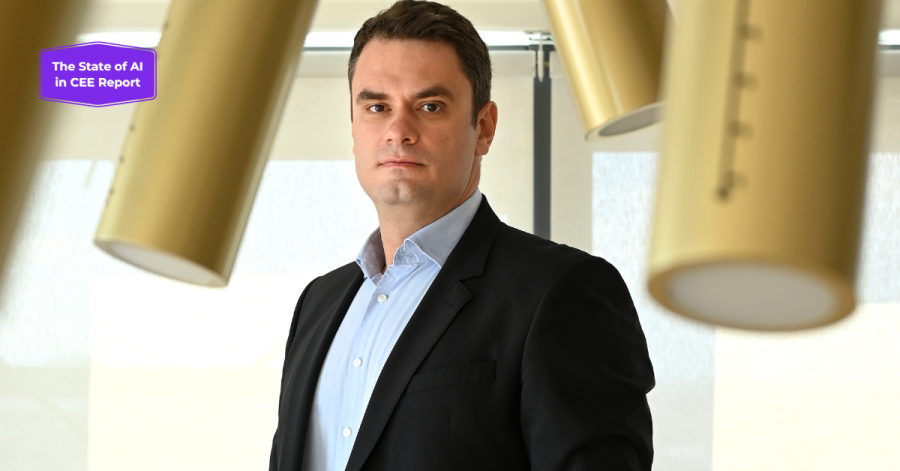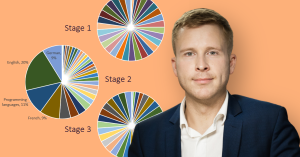“Considering our relatively smaller markets, it’s vital to view them as a collective entity to maximize resources and diversity. This strategy underpins our approach to regional cooperation.”
Ilia Krustev is the CEO and has led A Data Pro for more than 15 years.
Ilia has a strong passion for entrepreneurship and innovation with wide-ranging business interests and advocates for sustainable and innovative business practices and supports the startup ecosystem in the SEE.
Ilia Krastev is also the chairman of the Association for Innovation, Business Excellence, Services, and Technology (AIBEST), which represents the companies of high-value-added business services in Bulgaria, but also aims to build a bridge between these industries in SouthEast Europe.
We talk about the prospects of AI development in CEE and how to establish a stronger network for cooperation in the region.
The following interview was conducted as a part of The Recursive’s “State of AI in CEE” report. Download the full report with insights from 40+ experts and an analysis of 900 AI product companies from CEE here.
The Recursive: How does AIBEST contribute to the advancement of AI in the CEE region and globally?
Ilia Krastev: There are several key aspects to how AIBEST contributes to the advancement of AI both in the CEE region and on a global scale. To begin, we are deeply involved in enhancing cooperation between companies and leveraging technologies within the CEE system. The significance of AI has grown exponentially, particularly with the emergence of large language models this year. While it was a relevant topic before, the explosion of these models has taken it to new heights. Over the past few years, numerous companies have invested in AI, driving progress not only in Bulgaria but throughout the entire region.
As an association, our primary focus is to facilitate collaboration among companies. We achieve this through various avenues, including our internal initiatives. Within the association, we provide a platform for companies to showcase their AI-related technologies. We organize workshops where these companies collaborate with others interested in these technologies. The goal is to pool resources effectively and explore how they can maximize the benefits of these technologies. This approach is pragmatic and straightforward.
Another crucial aspect revolves around our efforts to influence the broader ecosystem. Starting this autumn, we’re embarking on an initiative in partnership with several schools. We’re launching a series of classes that delve into the realm of AI. Our target audience includes schools in key cities within our region (Burgas, Varna, Stara Zagora, Plovdiv) and potentially beyond. Our aim is to offer students a comprehensive understanding of AI and its potential applications. We’ve noticed a certain resistance within the centralized educational system when it comes to incorporating AI into the curriculum. On the flip side, outside of school, many students are already interacting with AI in various ways, often without even realizing it. It’s essential to bridge this education gap, not only from a technological perspective but also to help these students integrate effectively into our community.
Now, onto another facet of our work. We’re striving to establish a stronger network within Central and Eastern Europe. This network involves identifying best practices, solutions, and implementations across different domains. Essentially, we’re fostering connections between companies with specific expertise that can be shared throughout the region. This extends to resources as well; given the scarcity of AI talents, there’s a constant search for skilled individuals. By tapping into our network, we aim to facilitate the sharing of resources, which goes beyond just using existing products and services. We’re even exploring collaborative research and development projects based on each company’s goals and direction.
Considering our relatively smaller markets, it’s vital to view them as a collective entity to maximize resources and diversity. This strategy underpins our approach to regional cooperation. Furthermore, we hosted an annual conference in Sofia this September – SEE Innovation Technology and Sourcing Summit. The event serves as a platform for companies and associations from South Eastern Europe to converge physically. This conference encapsulates our endeavor to enhance exposure and efficiency in our initiatives.
How would you describe the current state of AI innovation in the CEE region? How do you envision the near future of AI in the CEE region in the next 5 years?
The current state of AI innovation in the CEE region is shaped by several key factors. Firstly, the aftermath of COVID-19 introduced a dynamic shift. The availability of abundant and affordable funds in the market was a prominent aspect. Concurrently, the pandemic induced a need for transformation in many companies. Automation, a concept that had been on the radar for some time, became a priority due to the changes in work patterns and production halts. This wasn’t limited to technology-focused businesses; it spanned across various sectors.
This urgency for adaptation ignited a surge in the exploration of existing technologies, including AI, that were previously underutilized due to concerns like potential job losses. The impetus from the market, which was a response to the challenges posed by the pandemic, pushed companies to allocate more resources toward automation. This surge in investments also triggered a significant increase in merger and acquisition (M&A) activities. However, there are nuances to this development. While global corporations made substantial investments in various technologies, the amalgamation of these technologies proved complex. The merging of technologies from different companies resulted in a lack of integration, slowed operations, and increased complexities, offsetting the anticipated gains.
What I’m seeing, is that companies in our region are moving more swiftly than larger corporations. The latter face numerous hurdles including regulatory compliance, consolidating technology investments, and the challenge of integrating AI within an infrastructure that spans globally with thousands of employees. This presents an opportunity unique to our market and region, where adaptable local companies are leveraging their advantages. Over the next one to two years, we can expect to witness a proliferation of captivating companies and products emerging from our region.
Currently, the CEE region is poised for a unique opportunity. The adaptability of smaller markets can translate into an advantage. Agile companies can pivot quickly, invest resources effectively, and adapt to change, all of which are essential in an evolving market. This is where the smaller scale of our markets can become an asset. The nimbleness of companies in our region positions them to potentially outpace larger corporations that often face challenges in swiftly implementing changes across their extensive operations. Conversely, larger markets are encountering a potential slowdown in activities like venture capital and private equity investments.
This dichotomy highlights the advantage that smaller markets have, where the necessary funding for initiatives is proportionate to the market size. Smaller markets require less capital compared to larger ones, making funding more accessible. This situation enhances the financial viability of AI-focused companies operating in the CEE region, creating a favorable environment for innovation and growth in the AI sector.
As AI continues to flourish, our region’s responsive companies stand to capitalize on this trend. This advantageous combination of nimble companies and a comparatively accessible funding landscape positions the CEE region as a potential hub for AI progress. Looking ahead, we anticipate a wave of intriguing AI products and ventures emerging from this region over the next couple of years.
An additional dimension to consider is the role of governments in the region. Their involvement in facilitating and promoting AI projects and initiatives is vital. The degree to which these governments embrace a supportive and forward-looking stance can significantly influence the trajectory of AI innovation and adoption within the CEE region.
How do you think the upcoming EU AI regulatory framework will impact the adoption of AI products and services?
The upcoming EU AI regulatory framework holds profound implications for the adoption of AI products and services, and this is a matter of considerable concern. The European Union’s stance on regulations, while often well-intentioned, poses significant challenges for companies engaged in research and development. It’s important to acknowledge that a certain level of regulation is essential, particularly in an area as transformative as AI. However, the issue arises when these regulations hinder innovation and competitiveness on a global scale.
The EU’s regulatory landscape is indeed more stringent compared to other markets like the US. This can put European companies at a disadvantage, especially when they are competing against counterparts from regions with more lenient regulatory environments. While the EU offers funding opportunities, it’s a delicate balance. The danger lies in a potentially vicious cycle: as companies attempt to keep up with increasing regulations, they may inadvertently slow down their own progress. The process of seeking additional funding can itself be time-consuming and less agile.
A concerning aspect is that the benefits of adaptability and agility, which are inherent to smaller markets, could be overshadowed by the escalating regulatory landscape. The reality is that more regulations lead to increased costs, which ultimately impacts the speed of innovation and implementation. While there’s an imperative for regulations, the approach must be carefully calibrated to prevent stifling innovation and growth.
While AI regulations are crucial, it’s important to note that achieving a global consensus on AI regulations is a complex challenge. The enforcement of regulations in a global context is an intricate matter, as various countries have divergent priorities and levels of compliance. This underscores the difficulty in attaining a harmonized set of regulations that truly govern AI usage on a worldwide scale.
And the end result of that might be that the European Union will lag behind in relation to current developments. There’s a possibility that companies might set up entities in regions outside the European Union due to more accommodating regulatory processes. Even now, some companies are considering establishing entities in the US or other markets beyond the EU due to the ease of regulatory procedures and R&D activities.
When it comes to AI and generative AI, the most significant risk for society, in my opinion, isn’t the doomsday scenario of massive job loss and economic collapse. It’s true that some jobs might disappear, but new ones will emerge too. What truly matters is how quickly we can adapt to these changes. Do we have a strategy in place to reshape our business models, our economy, and the industries specific to each market and country? If we don’t get it right, some companies might struggle or even fail. It’s a bit like survival of the fittest, not only for companies but also for countries. Countries won’t collapse, but they might face setbacks if they don’t adjust swiftly.
We need more discussions about the potential benefits that come with the technologies that are emerging. How can we make the most of these technologies, invest in them, and integrate them into education, businesses, regulations, and funding?
There’s an immediate and often overlooked risk. It’s the misuse of technology for propaganda, spreading fake news, and manipulating online content. The autonomous nature of online content is also a concern. Imagine having a tool that can churn out posts or opinions on any topic, instantly generating content that’s relevant locally or globally. Since the rise of large language models earlier this year, social media content has surged by around 10 to 15% for several months, and we haven’t even seen the full impact yet. There are APIs in the works that can automate content distribution across various social media platforms. This could result in posts that make people appear extremely knowledgeable or portray their country as a unique paradise or a total disaster. The immediate risk could reshape how society operates. A significant percentage of conversations on social media could be driven by bots or large language models, not real people. This even raises questions about the credibility of the media. If a tool can create content effortlessly and inexpensively, how do we gauge authority and trust in media? Who’s responsible, who’s the actual publisher?
The economy has a way of adapting – we’ve seen this through every Industrial Revolution. But the bigger issue is how society as a whole adapts. We’ve witnessed economists shape and reshape job markets over time, creating more jobs even as others are lost. But the critical question now is how society will handle these tools. Are people ready to wield this power? That’s a substantial, looming question and a significant risk.
What are some of the biggest challenges that AI innovators from the CEE region are facing during the development of AI-powered research, products, and services?
Building on the factors we’ve discussed, another significant challenge is the issue of tech transfer. This involves how companies collaborate with universities and the broader framework within which such collaborations occur. Establishing research and development centers that effectively support universities and companies requires a well-defined approach. While some companies are making strides in this direction, a comprehensive and established framework is lacking. This puts us at a notable disadvantage compared to other markets. Many other regions possess a structured ecosystem where university-industry partnerships thrive, fostering innovation and practical implementation. Addressing technological transfer complexities is no small task; it involves a lot of brain work and creating a solid framework.
There are some encouraging developments in Bulgaria, particularly in this regard, INSAIT being one of them. However, for these positive trends to scale up, we need a more structured and overarching approach. We can’t afford to merely highlight isolated cases as evidence of success; we need holistic and impactful changes to our educational system.
When we assess the educational landscape, considering the average scores from the matriculation exams in math and the Bulgarian language across schools, a concerning trend emerges. Despite significant investments in education, the outcomes don’t match up. While we applaud students participating in events like the Math Olympics, we need to scrutinize the broader picture. What’s the overall quality of education we’re providing? This holds true for both schools and universities.
Therefore, an increased focus on STEM education is essential. The need for technological transfer dovetails with the education landscape – whether it’s the collaboration between universities and companies or the curriculum shaping young minds.
Furthermore, one of the crucial challenges lies in our approach to schools – how well are we preparing students for a rapidly changing world? Our ability to attract and retain talent in Bulgaria hinges on two key elements: creating an attractive living and working environment and offering compelling educational opportunities.
A substantial portion of talented individuals opt to study abroad, leading to a weakened pool of applicants at domestic institutions. This trend continues as some graduates also seek opportunities beyond our borders.
In my view, this challenge – the erosion of our talent pipeline due to educational inadequacies – presents a glaring risk. It underpins the very fabric of an AI innovation ecosystem, affecting both immediate and long-term prospects.








